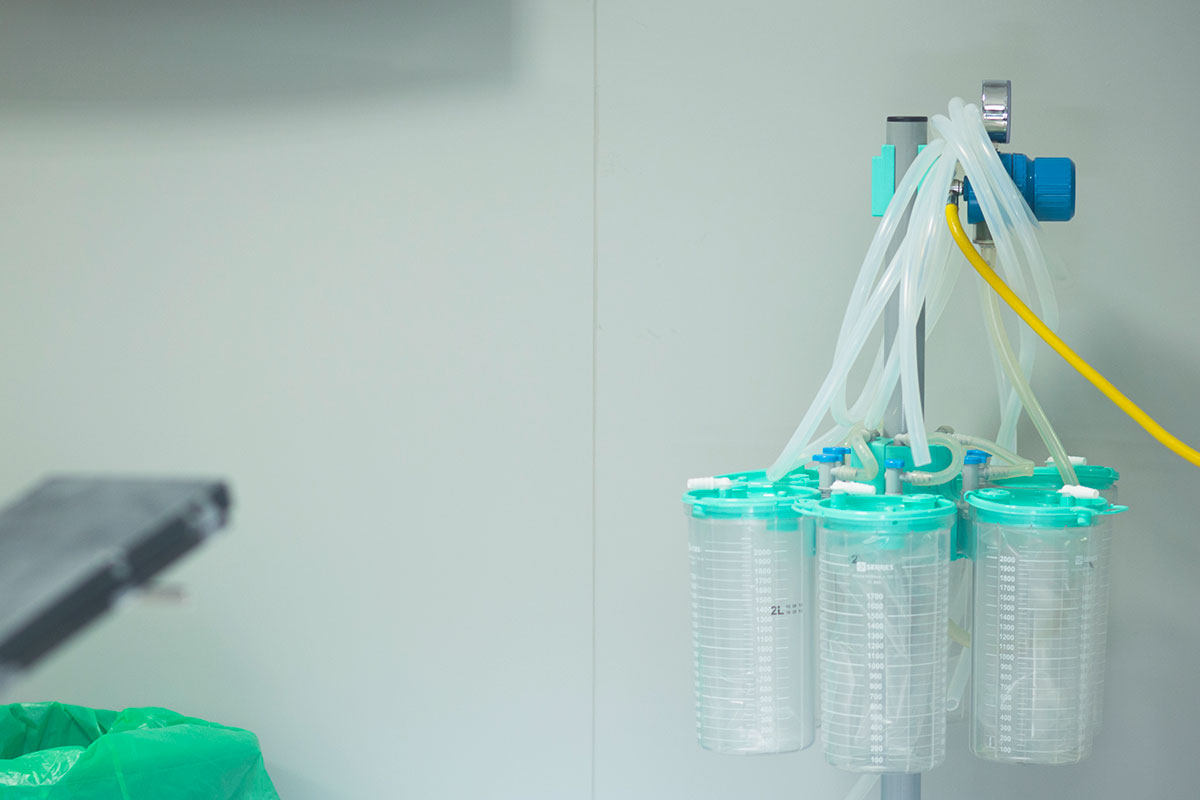As of March 1, 2021
20 percent of hospital waste is generated in the operating room. Liquids play a major role in this. Various types of fluids, such as water, rinsing fluids, blood and detergents are produced during operations. Every drop must be collected, safely stored and disposed of without endangering the patient, nursing staff or the environment. In this ABC article, we explain which disposal routes are available.
–
Nowadays, disposable suction systems are used almost exclusively in the operating theater, in which the fluids that accumulate are drained off, placed in a container or bag and gelled there. These can then be disposed of as residual waste (AS 180104). The amount of waste generated by this practice is quite high. In addition, care must be taken with this method that the waste handling system and its operation are designed in such a way that the escape of liquid or solid materials is avoided. Although this waste can in principle be assigned to waste code 180104, it cannot be collected in plastic bags due to the high proportion of liquid and the associated risk of leakage. The LAGA provides the following procedure here: “For larger amounts of body fluids (e.g. urine, blood, drainage fluids) in containers, B. to ensure through the use of suitable absorbent materials that no liquid waste is released when this waste is provided and transported ”. If this cannot be ensured, the waste must be assigned to AS 180102.
Body fluids and excretions from patients treated with cytostatic drugs are not considered to be hazardous and can also be disposed of as 180104 in compliance with the hygiene guidelines.
Disposal as 180102
The waste that falls under the waste key number 180102 must be transported in securely closed, suitable containers. Many hospitals use tight-fitting plastic containers with a volume of 30, 50 or 60 liters for collection. The provision of body fluids and organ waste must be carried out until collection and disposal in such a way that gas formation is excluded. When filling the container, the maximum permissible filling weight of the container must be observed!
The situation is different, however, with liquids that arise during operations on patients with infectious diseases. These fall under AS 180103 *. These include blood-filled vessels and blood-soaked waste from operations on infectious patients, from relevant specialist practices and laboratories, as well as used dialysis systems from the treatment of known virus carriers.
All waste from AS 180103 * must be collected in tear-proof, moisture-resistant and leak-proof containers (e.g. type-tested hazardous goods packaging) directly at the place where it occurs and stored in suitable, securely closed containers (possibly bags in combination with return containers) without being refilled or sorted central collection point.
In the case of fecal-orally transmitted infections, urine and stool can be discharged into the sewage system, taking personal hygiene and occupational health and safety into account.
Disposal via sewage
In principle, according to LAGA, individual containers with body fluids may be emptied, taking into account hygienic and infection-preventive aspects of occupational health and safety, and the contents may be discharged into the wastewater in compliance with water management regulations (municipal wastewater statutes).
At a maximum care clinic, between 50 and 100 liters of body fluids may have to be disposed of every day. According to Springer medicine In the same period of time, a waste water volume of 470 m3 is created. As a result, body fluids are not to be seen as significant additional pollution for the wastewater and can be introduced into the municipal wastewater. There is no additional risk of infection from the introduction of small amounts of possibly microbiologically contaminated body fluids.
The situation is different with laboratories or quarantine facilities: Here, the wastewater cannot simply be disposed of via the domestic water network, as it could contain potentially dangerous substances that cannot be inactivated by sewage treatment plants or that can destroy the bacterial cultures present there. A wastewater sterilizer ensures that even larger quantities are safely inactivated.
Closed waste management systems
There are now closed waste management systems for surgical fluids. These collect, transport and dispose of the resulting liquid. Liquids extracted in this way are isolated during the operation. The system then discharges the liquids directly into the wastewater. If this possibility of disposal is permitted by the municipal wastewater ordinance, it represents a disposal variant that gets by with less waste. In addition, this offers a high level of safety for the staff, as the self-contained system means that there is no exposure to blood splashes or wet floors due to the escape of liquids. With these systems, the only waste generated is the intake manifold that has to be changed.
– .


